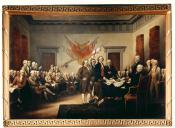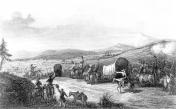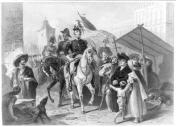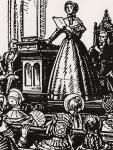History of Congress and the Capitol
This is the story of one of the world's great experiments in government by the people.
For more than two centuries, a new Congress has convened every two years following elections that determine all the seats in the House and one-third of those in the Senate. While the individuals change, the institution has endured-through civil and world wars, waves of immigration and great migrations, and continuous social and technological change.
Following the War of 1812, a stronger sense of national unity emerged in the United States. As America expanded westward, however, attempts to spread slavery into those new territories seriously divided the nation.
Conflict and Compromise
Free or slave? As America expanded after the War of 1812, new territories began to choose.
In the House, slavery foes resisted spreading the South's "peculiar institution" to new states. Southern representatives feared that admitting more free states would tip the delicate balance against them.Missouri’s bid to enter the Union as a slave state, carved from the Louisiana Purchase, sparked controversy in 1819 and 1820. Twenty-six years later, a fight flared over a House amendment banning slavery in all land gained from the Mexican War. Immigration to Northern states meant that with each Federal census, the proportion of free-state representatives in the House grew. Defenders of slavery increasingly felt threatened.
A House Divided
Slavery tied the House in knots. As the proportion of slave-state representatives dwindled, Southern members frantically tried to defend their interests. First, they changed House rules to keep slavery off the agenda automatically by banning the discussion of antislavery petitions. Later, as the two political parties continued to split into Northern and Southern factions, Southern candidates for House Speaker disrupted both parties so completely that weeks of voting produced no result. Such deadlocks shifted momentum to the Senate, which remained evenly divided between slave states and free, and thus was better able to negotiate compromises between North and South.
Regional Disputes
With an equal number of senators representing slave and free states, the Senate became the setting for explosive issues that increasingly divided the industrialized North, the agricultural South, and the rapidly expanding West.
Emerging from the shadow of the House of Representatives, the Senate matured into a creative and active lawmaking body. By 1850, it had grown to 62 members. Yet, unlike the far larger, more crowded House Chamber, the Senate still offered a relatively intimate setting that encouraged extended debate.
A Forum for Orators
The Senate's tradition of letting senators debate without time limits, and its relatively small size, encouraged great speakers. The even split between North and South inspired the orators. Daniel Webster of Massachusetts delivered two of the most significant speeches in American political history on the Senate floor: his “Second Reply to Hayne” (1830) and the “Seventh of March 1850” address.
Passionate words reflected senators' determination to exercise their power. Bitter struggles with President Andrew Jackson and his successors over the economy tested and reinforced the Senate's power, allowing the chamber to evolve into its modern role as a leading forum for setting national policies.
A Growing Nation and Capitol
As the United States expanded across the continent, laborers in Washington were finishing the Capitol.
Early in this period, the building consisted of just two wings, both badly damaged by British attacks in the War of 1812. Congress returned to Washington soon after the fires died down, debating whether to rebuild—or to pack up and move back to Philadelphia.
Congress chose to rebuild. It began work reconstructing the two wings, later uniting them with the long-delayed center building. At last, in 1829, the Capitol and its landscaping were complete. But within 20 years, the nation had outgrown the building.
Images of the Era - 1815-1851
-
The Capitol, engraving, by Wilfred Jones, 1848
With 31 states represented, Congress was outgrowing the rebuilt and newly expanded Capitol by 1850.
Prints and Photographs Division, Library of Congress
-
Traders opened the Santa Fe Trail from Missouri to the Southwest in 1822.
Prints and Photographs Division, Library of Congress
-
In Virginia and other Southern states
In Virginia and other Southern states, agriculture continued to shape the landscape, economy, and culture.
Prints and Photographs Division, Library of Congress
-
The 1830 Indian Removal Act
The 1830 Indian Removal Act forced southeastern Cherokees, Creeks, Seminoles, Choctaws, and Chickasaws westward onto reservations, along the Trail of Tears.
Jerome Tiger, Endless Trail, 1966, Museum purchase, 1966.11.2, ©2010 The Philbrook Museum of Art, Inc., Tulsa, Oklahoma
-
In 1839, African captives on the slave ship Amistad mutinied
In 1839, African captives on the slave ship Amistad mutinied; the Supreme Court upheld their right to freedom.
Prints and Photographs Division, Library of Congress
-
Mid-Atlantic and Northern states had abundant natural resources for industrial power and production.
Courtesy of The Maryland Historical Society
-
The cotton gin made large-scale production of cotton profitable, leading to the expansion of slavery.
Prints and Photographs Division, Library of Congress
-
U.S. forces invaded Mexico in 1846, claiming nearly half of Mexico’s territory for the United States. Here, General Scott enters Mexico City with his troops.
Prints and Photographs Division, Library of Congress
-
Prospectors rushed to California and Colorado following gold discoveries in 1848 and 1859.
Prospectors rushed to California and Colorado following gold discoveries in 1848 and 1859.
Seaver Center for Western History Research, Los Angeles County Museum of Natural History
-
The woman suffrage movement officially began at this meeting in Seneca Falls, New York, in 1848.
The woman suffrage movement officially began at this meeting in Seneca Falls, New York, in 1848.
Culver Pictures
-
The Erie Canal, completed in 1825, provided passage from the Hudson River to Lake Erie.
The Erie Canal, completed in 1825, provided passage from the Hudson River to Lake Erie.
Reproduced from American Scenery, by Nathaniel Parker Willis, General Collections, Library of Congress
-
Treaties with Indian Nations
Early treaties between the United States and Native Americans were acts of nation-to-nation diplomacy. Trade agreements were forged with Indian nations in hopes of discouraging alliances with France or Britain. As settlers moved westward, however, they placed pressure on the federal government to urge tribes to abandon the land. In 1830, Congress passed the Indian Removal Act, giving the president power to negotiate "removal treaties," under which Indians were often made to give up lands in exchange for reservations.



















